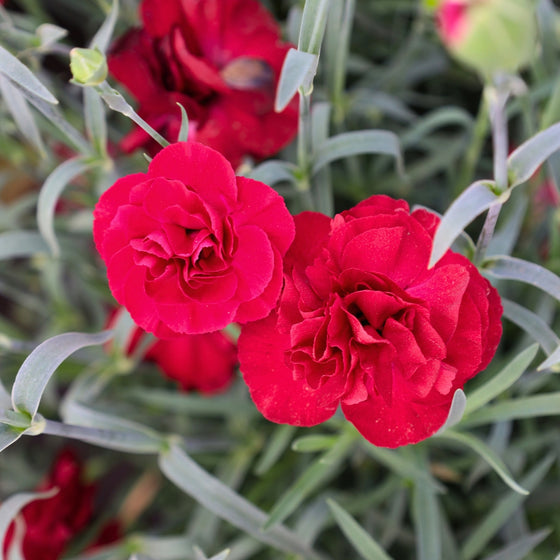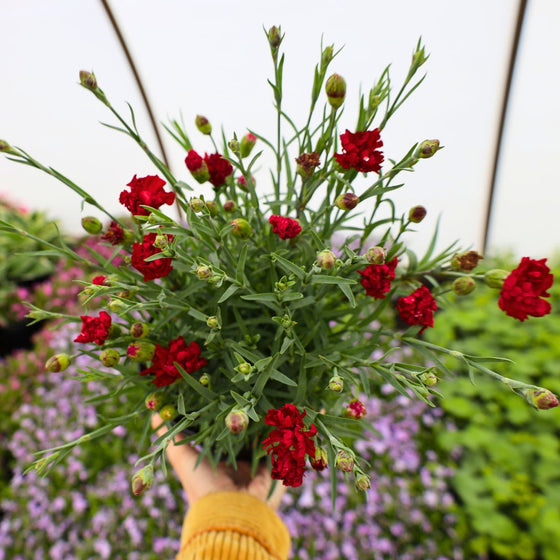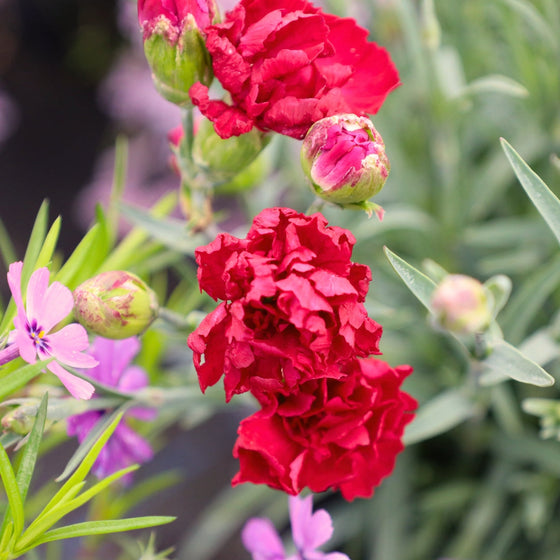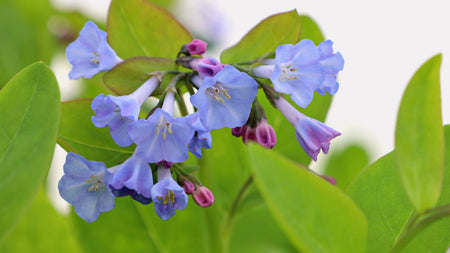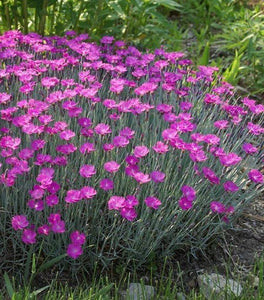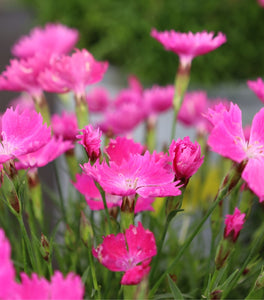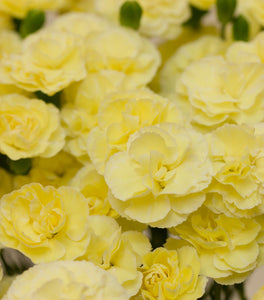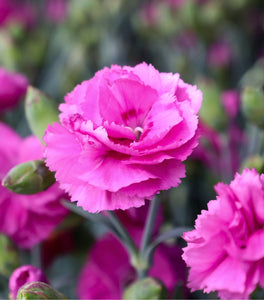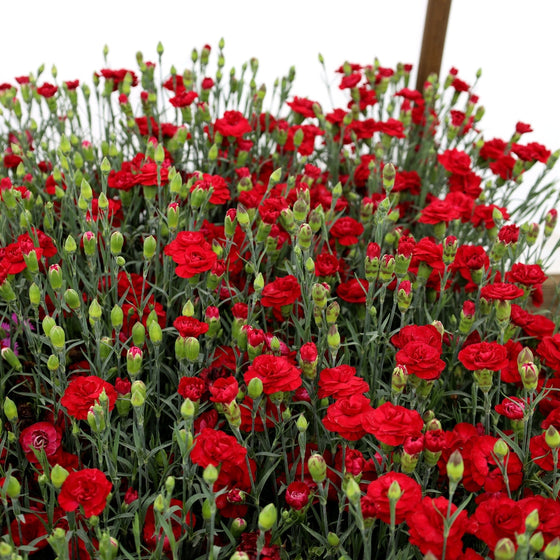
Images Depict Mature Plants
Dianthus Passion
Dianthus ‘Passion’, also known as Passion Pinks, is a stunning perennial that brings rich color, fragrance, and texture to the landscape. This compact, mounding plant features vivid magenta-red blooms with delicate fringed petals that bloom profusely from late spring into early summer, often reblooming with proper deadheading. The silvery-blue, evergreen foliage provides year-round interest and forms a tidy cushion-like base, making it ideal for borders, rock gardens, and cottage-style landscapes.
Growing just 8 to 12 inches tall and wide, Dianthus Passion is perfect for mass plantings, edging pathways, or filling containers and window boxes. It thrives in full sun and well-drained soil, showing excellent drought tolerance once established. This low-maintenance perennial is not only eye-catching but also a magnet for bees and butterflies, bringing life and movement to pollinator-friendly gardens.
In addition to its beauty and ease of care, Dianthus Passion is deer resistant, making it a reliable choice for landscapes prone to browsing. Its compact size and repeat blooming habit ensure season-long color and versatility. Whether you’re designing a fragrant front yard, brightening a patio container, or lining a garden path, Dianthus ‘Passion’ delivers bold color and timeless charm in a petite, hard-working package.

| Hardiness Zone: | 5-9 |
|---|---|
| Mature Height: | 8 to 12 Inches |
| Mature Width: | 8 to 12 inches |
| Sunlight: | Full |
| Water Requirements: | Water well only until established |
| Flower Color: | Fire Truck Red |
| Details: | Fragrant flowers, attracts butterflies |
How to Care for Dianthus Passion
Before you buy a Dianthus Passion Plant, make sure to read about the recommended care instructions to keep this plant healthy and thriving.
How Do I Plant A Dianthus Passion Plant?
To plant a Dianthus ‘Passion’ plant, choose a location that receives full sun and offers well-drained soil, which is essential for healthy root development and flower production. Dig a hole twice as wide and the same depth as the plant’s root ball, and gently loosen the roots before placing it into the hole. Backfill with native soil or a well-draining soil mix, firm the soil around the base, and water thoroughly to help the plant settle in. If you’re planting multiple Dianthus ‘Passion’ plants for a mass effect or border, space them about 8 to 12 inches apart to allow for mature growth and proper air circulation. Dianthus Passion thrives in raised beds, rock gardens, containers, or along pathways, where the soil is less likely to stay soggy. Avoid planting in low-lying areas where water may accumulate, as overly wet conditions can lead to root rot. For added success, mix a little compost or organic matter into the planting area to boost drainage and nutrient content. Once planted, mulch lightly around the base—keeping it away from the crown—to help retain moisture and suppress weeds while still allowing good airflow. With the right planting technique and site conditions, Dianthus ‘Passion’ will reward you with vivid blooms and charming garden appeal.
How Do I Water A Dianthus Passion Plant?
Watering your Dianthus ‘Passion’ plant properly is key to maintaining healthy foliage and a vibrant, continuous bloom cycle. After planting, water thoroughly and keep the soil evenly moist for the first few weeks to help establish strong roots. Once established, Dianthus Passion is drought-tolerant, and prefers soil that is slightly dry between waterings. Overwatering can lead to root rot and fungal diseases, especially in poorly drained soils, so it’s essential to let the top inch of soil dry out before watering again. For best results, water your Dianthus Passion plant at the base, avoiding overhead watering, which can promote mildew on the foliage and flowers. During hot or dry weather, check the soil regularly and provide supplemental water if necessary, particularly for plants in containers or raised beds that dry out faster. In cooler seasons or periods of frequent rain, scale back watering to prevent soggy conditions. With the right balance, your Dianthus Passion will reward you with a long season of fragrant, magenta-red blooms and healthy, compact growth.
How Do I Fertilize A Dianthus Passion Plant?
To fertilize a Dianthus ‘Passion’ plant effectively, apply a balanced, slow-release fertilizer—such as a 10-10-10 formula—in early spring as new growth emerges. This initial feeding provides the essential nutrients needed for lush foliage and abundant magenta-red blooms throughout the season. Spread the fertilizer evenly around the base of the plant, avoiding direct contact with the crown, and water thoroughly to help the nutrients penetrate the root zone. For garden beds, incorporating a light layer of compost at planting time can also improve soil fertility and drainage. As the growing season progresses, you can give your Dianthus Passion a light midseason feeding using a water-soluble bloom booster to encourage repeat blooming. Avoid over-fertilizing, as too much nitrogen can lead to excessive foliage growth at the expense of flowers. For container-grown plants, fertilize more frequently—every 4–6 weeks—with a diluted liquid fertilizer to replenish nutrients lost through watering. With a thoughtful fertilizing routine, your Dianthus Passion will thrive with vivid blooms, compact growth, and long-lasting garden appeal.

How and When Do I Prune A Dianthus Passion Plant?
Pruning your Dianthus ‘Passion’ plant is essential to maintain its compact shape and promote repeat blooming throughout the season. Begin by deadheading spent flowers regularly, snipping them just above the nearest set of healthy leaves. This not only keeps the plant looking tidy but also encourages the production of new buds, extending the flowering period well into late summer. Use clean, sharp scissors or pruners to avoid damaging the stems, and remove any discolored or wilted foliage to improve air circulation around the plant. At the end of the growing season, typically in late fall, you can perform a light rejuvenation pruning by cutting the plant back by about one-third. This helps prepare the Dianthus Passion for overwintering and promotes bushier growth in the spring. In early spring, once new growth appears, trim away any winter-damaged stems to give the plant a fresh start. With timely pruning, your Dianthus ‘Passion’ will remain full, healthy, and covered in brilliant blooms season after season.

